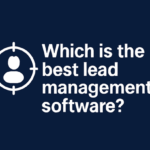In today’s competitive business world, the ability to manage leads effectively can significantly enhance the efficiency of marketing teams. Proper lead management helps companies build strong relationships, increase conversion rates, and ultimately boost sales performance. For marketing teams, adopting best practices for lead management is crucial for success. This article will explore key strategies, tools, and techniques that ensure marketing teams can capture, nurture, and convert leads effectively.
Understanding Lead Management in Marketing
Lead management refers to the process of capturing, tracking, and nurturing potential customers, also known as leads, throughout the entire sales funnel. It involves organizing leads, scoring them based on their likelihood to convert, and engaging them with targeted marketing strategies. A strong lead management system helps marketing teams improve conversion rates and make the most out of every potential opportunity.
A streamlined lead management process ensures that each lead receives timely follow-ups, personalized content, and relevant offers, which leads to a higher probability of conversion. For marketing teams, integrating tools like CRM systems and marketing automation platforms into the lead management process can provide valuable insights and efficiencies that significantly improve outcomes.
Capturing Leads Effectively
The first step in effective lead management is capturing high-quality leads. Marketing teams need to use various tools and methods to generate leads consistently. Below are some of the best practices for lead capture:
Landing Pages and Forms
Well-designed landing pages with clear, compelling calls-to-action (CTAs) are essential for capturing leads. Ensure that forms are simple yet effective in collecting relevant information. A well-optimized landing page should address potential leads’ pain points while providing a clear and actionable next step, such as a form submission or download.
Content Marketing
Offering valuable content, such as ebooks, whitepapers, and webinars, in exchange for contact details is a great way to attract leads. This method builds trust and positions the brand as an authority. Marketing teams can use content offers tailored to their audience’s needs, ensuring that they’re providing value in exchange for the prospect’s information.
SEO and Paid Ads
By optimizing web pages for search engines and investing in paid advertising, businesses can reach a broader audience. This method is effective in bringing targeted traffic to your website and generating qualified leads. SEO (Search Engine Optimization) can ensure organic traffic growth, while paid advertising can amplify reach and target a specific customer segment.
Social Media Engagement
Social media platforms can be powerful tools for generating leads. By engaging with followers, sharing valuable content, and utilizing ads, marketing teams can capture leads through these channels. Platforms like LinkedIn, Facebook, and Instagram provide opportunities to target ads precisely, ensuring they reach the most relevant audience.
Lead Qualification: Scoring and Categorizing
Once leads are captured, it’s vital to evaluate their quality. Not all leads are equal, and marketing teams need to prioritize the ones with the highest chances of conversion. Lead scoring is a strategy that assigns a numerical value to each lead based on various factors, such as:
Demographic Information
Information such as age, job title, and company size can help determine if the lead is a good fit for your business. B2B companies may focus on company size and industry as key factors, while B2C companies may look at age and location.
Behavioral Data
Tracking how leads interact with your website, emails, and content can provide valuable insights into their intent and engagement level. Behavioral data includes actions like downloading a whitepaper, attending a webinar, or clicking on a CTA. This data gives marketing teams a better understanding of lead interests and their readiness to convert.
Engagement Level
Leads who have shown significant interest (e.g., downloading a case study or attending a webinar) should be prioritized over those who have shown minimal engagement. The level of engagement can be a strong indicator of the likelihood to convert. Higher engagement scores typically result in a higher priority in the follow-up process.
Nurturing Leads with Automation
Once leads are captured and qualified, they need to be nurtured effectively to move them further down the sales funnel. Lead nurturing involves providing valuable content and communication that keeps leads engaged. The following methods ensure successful lead nurturing:
Email Marketing Automation
Automated email campaigns help maintain consistent communication with leads. Sending personalized, targeted emails based on lead behavior and preferences can increase the chances of conversion. Automation allows marketing teams to send follow-up emails, reminders, and product updates without manual intervention, improving efficiency.
Segmentation
Segmentation is the process of dividing leads into groups based on shared characteristics. By segmenting your audience, you can deliver tailored content that resonates with each group’s unique needs. For example, you can segment by job title, company size, or stage in the buyer journey.
Lead Scoring and Automation Tools
Integrating lead scoring with marketing automation tools helps to track and engage leads based on their behaviors. These tools can trigger actions like sending emails or notifications based on predefined rules, ensuring that leads receive timely communication and offers.
Personalized Content
Offering personalized content, such as product recommendations, case studies, and webinars, helps nurture leads and increases the likelihood of conversion. Personalization increases relevance, which improves the overall lead nurturing process and builds trust.
Utilizing CRM Systems for Efficient Lead Tracking
A Customer Relationship Management (CRM) system is essential for managing leads throughout their journey. A CRM system allows marketing teams to track, categorize, and engage with leads in real-time. Some of the key benefits of using CRM systems include:
Centralized Lead Data
A CRM system ensures that all lead data is stored in one central location, making it easily accessible for the team. This eliminates the risk of losing valuable lead data and ensures that all team members are on the same page regarding lead status and next steps.
Enhanced Collaboration
CRM systems improve communication between marketing and sales teams, ensuring a smooth transition of leads from one stage to the next. Effective collaboration ensures that leads are not neglected or forgotten, and they continue to progress through the sales funnel.
Automated Follow-ups
CRM tools can automate follow-ups, ensuring that no lead is forgotten and that the marketing team can focus on high-priority prospects. Automated reminders and tasks help streamline the process and ensure timely communication with leads.
Insightful Analytics
CRM systems provide detailed reports and analytics on lead performance. By analyzing this data, marketing teams can identify areas of improvement and optimize lead management strategies. Insights such as lead source, conversion rate, and average deal size help inform future marketing decisions.
Optimizing Conversion Rates
The ultimate goal of lead management is converting leads into customers. Effective conversion strategies rely on a combination of timing, relevance, and communication. Here are some tips for optimizing conversion rates:
Timely Follow-ups
Research shows that leads who are contacted within the first hour of their inquiry are more likely to convert. Set up automated systems for immediate follow-ups to capitalize on this. Speed is crucial in lead conversion, so quick responses can significantly improve your results.
Clear and Compelling CTAs
Every piece of communication, whether it’s an email or a landing page, should have a clear, compelling CTA that directs leads towards the next step in the journey. A well-placed and well-worded CTA can encourage leads to take action and move closer to conversion.
Lead Nurturing Campaigns
Continuously educate and guide leads through the sales process with regular follow-ups, reminders, and value-based content. Keep leads engaged with relevant content that addresses their pain points, positioning your product as the solution.
Offer Incentives
Offering limited-time discounts, free trials, or exclusive offers can encourage leads to take the final step and convert into customers. These incentives create a sense of urgency and motivate leads to act quickly.
Measuring Success with Key Metrics
To ensure the effectiveness of lead management efforts, it’s essential to measure and analyze the success of your strategies. Key performance indicators (KPIs) provide valuable insights into the performance of lead management. Some important KPIs to track include:
Conversion Rate
This is the percentage of leads that ultimately become paying customers. Tracking conversion rates helps marketing teams identify weaknesses in the lead management process and take corrective actions.
Lead Response Time
The quicker the response time, the higher the chance of conversion. Monitoring lead response time can help optimize follow-up processes and ensure that leads are contacted at the most opportune moments.
Cost per Lead (CPL)
This metric calculates how much it costs to acquire a lead. By analyzing CPL, teams can identify the most cost-effective lead generation channels. This helps in optimizing the budget for paid advertising and other lead generation tactics.
Lead Velocity Rate
This metric tracks the speed at which leads move through the sales funnel. A higher velocity indicates an efficient lead management system. Faster lead movement suggests that marketing and sales teams are effectively collaborating and engaging leads.
Conclusion: Consistency and Adaptation for Lead Management Success
Effective lead management requires consistency and adaptation to ever-changing market conditions. By capturing high-quality leads, qualifying them, nurturing them with automation, and tracking them through CRM systems, marketing teams can significantly improve conversion rates. It’s essential to continuously evaluate lead management strategies and adjust them as necessary based on data and analytics. Following these best practices will ensure that marketing teams can turn leads into long-term customers, driving business growth.














